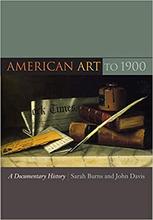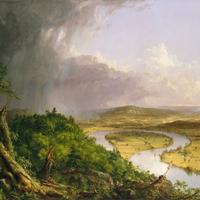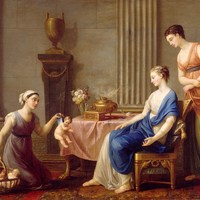More about Thomas Cole
- All
- Info
- Shop
Works by Thomas Cole

Contributor
Thomas Cole was born for too-cute narrative allusion.
Born in England at the turn of the 19th century, Cole’s family moved to America seeking a better life, dabbling in many trades sounds like the intro to a Rip Van Winkle-esque allegory. Decades later his work actually defined and predicted the continuation of that great American tradition of ruthless colonization, Manifest Destiny. The third chapter is just cow skulls on the side of the highway. Ah, the USA.
Cole is the founding father and inspiration for the Hudson River School, which one critic calls “America’s first true artistic fraternity.” He spawned an entire generation of artbros like Frederic Edwin Church who would travel much of the continent, following the Manifest Destiny that Cole himself predicted.
But Cole wasn’t necessarily “about” Manifest Destiny. Sure he painted the American landscape as totally vast and wild with a typically colonial ignorance of +40,000 years of human civilization that thrived in the “wilderness” until his folks showed up. But Cole saw Europe as bearing the scars and ravages of human civilization gone wrong and America’s virgin woods presented white people with a chance to get it right.
Cole loved John Milton, which is suspect because yeah, Paradise Lost is a masterpiece, but so is Moby Dick and it’s not like we’re lining up for a lunch date with Melville. But Cole thought the fate of the American landscape was a contemporary Edenic choice. Americans: you can eat the fruit of the tree of knowledge, again, and just be the worst kind of European knock-off, or you can kick it in paradise with your proverbial and collective feet up. Luckily he died in 1848 before he could really see which of those options America picked.
Cole is remembered as a painter but dude had other tricks up his sleeve. Quakers offered him a spot as resident flautist, room and board included. Several New York magazines and newspapers published his poems and letters. And he dabbled pretty seriously in architecture. His designs for the Ohio Statehouse earned a prize (3rd place in the competition, but not bad for a painter) and some of his ideas were actually used, he designed and built his studio in Catskill, NY, and designed an Episcopal church. This interest in architecture spilled back into his paintings, which sometimes feature idealized or fully tripped-out buildings in a kind of utopian suggestion that we can build ourselves into a better world – of course we know how that went.
During his lifetime American patrons welcomed his realistic depictions of the American landscape while European viewers found them too idealized. So if Americans really believed themselves to be the offspring of Europe, it’s really no surprise that the baby nation missed the option to build something better that Cole’s work presented its viewers. Now his paintings look romantic instead of realistic and we have 24 hour grocery stores instead of cars that poop flowers. Progress...?
Sources
- Avery, Kevin J. “The Hudson River School.” Heilbrunn Timeline of Art History. New York: The Metropolitan Museum of Art, 2004. Accessed October 19, 2017. https://www.metmuseum.org/toah/hd/hurs/hd_hurs.htm
- Beckenstein, Joyce. May 27, 2016. “The Painter Thomas Cole, and His Architectural Ambitions.” The New York Times May 29, 2016. Accessed October 18, 2017. https://www.nytimes.com/2016/05/29/nyregion/the-painter-thomas-cole-and…
- “Biography of Thomas Cole.” Thomas Cole National Historic Site. Accessed October 19, 2017. http://thomascole.org/biography-of-thomas-cole/
- Cunner, Eugene R. “ Ut Pictura Poesis: Thomas Cole’s Painterly Interpretations of L’Allegro and Il Penseroso.” Milton Quarterly: Volume 24 Number 3, October 1990. Accessed October 19, 2017. http://onlinelibrary.wiley.com/doi/10.1111/j.1094-348X.1990.tb004
- “Expulsion from the Garden of Eden.” Museum of Fine Arts Boston, 2017. Accessed October 19, 2017. http://www.mfa.org/collections/object/expulsion-from-the-garden-of-eden…
- “Thomas Cole.” Ohio History Central. Accessed October 19, 2017. http://www.ohiohistorycentral.org/w/Thomas_Cole
- “Thomas Cole (1801-1848).” Questroyal Fine Art LLC., 2017. Accessed October 19, 2017. https://www.questroyalfineart.com/artist/thomas-cole/
- White, Phillip M. American Indian Chronology: Chronologies of the American Mosaic, Westport, CT: Greenwood Press, 2006. Accessed October 18, 2017. https://books.google.com/books?id=_VnZ8_2kSScC&pg=PA1#v=onepage&q&f=fal…
Featured Content
Here is what Wikipedia says about Thomas Cole


Thomas Cole (February 1, 1801 – February 11, 1848) was an American artist who founded the Hudson River School art movement. He painted romantic landscapes and history paintings. Influenced by European painters, but with a strong American sensibility, he was prolific throughout his career and worked primarily with oil on canvas. His paintings are typically allegoric and often depict small figures or structures set against moody and evocative natural landscapes. They are usually escapist, framing the New World as a natural eden contrasting with the smog-filled cityscapes of Industrial Revolution-era Britain, in which he grew up. His works, often seen as conservative, criticize the contemporary trends of industrialism, urbanism, and westward expansion.
Check out the full Wikipedia article about Thomas Cole





















I love Thomas Cole's artwork simply because unlike most neoclassicist paintings, they're not portraits. Instead they focus on architecture and landscapes, which reflect the ancient cultures in different ways than a portrait would. For example, a portrait may show characters from a myth or the clothing may reflect ancient cultures, but architecture shows you ancient design and landscapes can tell more of a story of myths or tales.